Constant thoughts of pictures never done before
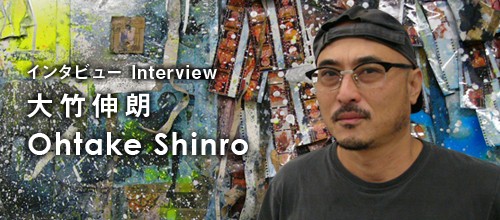
The Shinro Ohtake Zen-kei Retrospective 1955-2006 staged at the Museum of Contemporary Art Tokyo in 2006 was an unconventional attempt to present in toto the journey of this intensely private artist – drawing, sticking, copying, creating – in chronological order from early childhood up to the present; literally a ‘zenkei’ or panoramic view of his artistic endeavors. Three years on, Ohtake continues to tackle new ‘views’ of various sorts. We caught up with him at his latest solo show.
Interview: ART iT
– We last spoke to you three years ago for our thirteenth issue, just prior to the opening of the Zen-kei show. May I start by asking your impressions of that exhibition, looking back now?
Once everything’s done and dusted, you find it passed all too soon, really. In terms of the outcome, obviously I’m very pleased the show became reality, and that I did it. I suppose you could describe it as a milestone of sorts. Moving from Tokyo to Uwajima, and being surrounded by people with virtually no interest in what I was doing, conversely prompted me to ask myself some pretty searching questions about art and what it’s really all about. The Zen-kei show was staged after twenty years of such questioning and questing, which is one reason I was keen to present it in chronological order. In terms of attendance (eds: over 55,200), frankly I was delighted, but on the other hand, knowing that many of those who saw the show had never heard of me before did make me wonder at times why I’d soldiered on for close to three decades.
I don’t think the Zen-kei show changed me in any major respect, but the flow-on from it was excellent. That is, my first big job after the show turning out to be a piece like Naoshima Bath ‘I♥湯’ (I Love Yu), and also becoming acquainted with a young gallery like Take Ninagawa and thus finding an ongoing outlet for my day-to-day work.
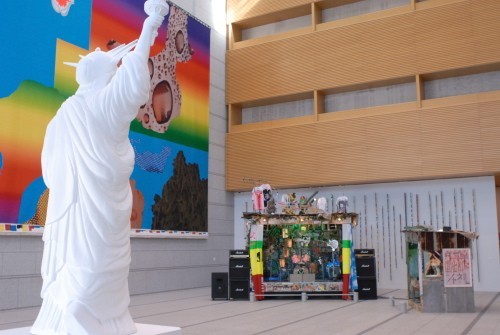 Installation view of Shinro Ohtake: Zen-kei Retrospective 1955-2006 (Museum Contemporary Art Tokyo, 2006)
Installation view of Shinro Ohtake: Zen-kei Retrospective 1955-2006 (Museum Contemporary Art Tokyo, 2006)Photo Hirano Kuniko Courtesy Museum Contemporary Art Tokyo
The intensity of place sensed in Naoshima Bath ‘I♥湯’
– Word has it you initially thought ‘I♥湯’, which opened this summer after two years in the making, was to be simply some murals for the bathhouse, then you realized they were commissioning you to actually make a public bath for the islanders from scratch.
That’s right. So I began by building a 1/30 scale model, telling the graf team in Osaka how I wanted to do things, while getting their advice on various aspects. I’m not terribly interested in buildings that overtly trumpet their contemporary art credentials. Nor, I imagined, would people on the island be into that. So I aimed to provide a place, a setting that was bright and cheerful, that hopefully the islanders would take to their hearts. Oh, and there was a request to ‘make it a bit of a turn-on’ (laughs).
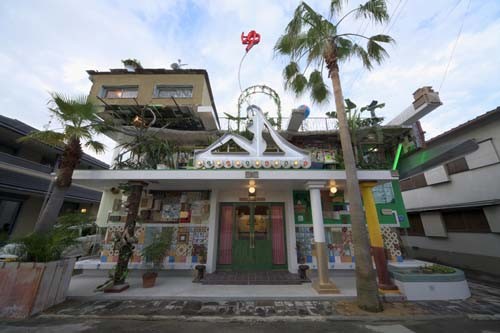 Naoshima Bath ‘I♥湯’ Photo Watanabe Osamu
Naoshima Bath ‘I♥湯’ Photo Watanabe Osamu
Naoshima Bath ‘I♥湯’
– You have two- and three-dimensional collages running from the outside walls to the bathtubs, picture tiles, and cacti and other potted plants also used in a similar way. Would it be fair to say your encounter with the floral artist Azuma Makoto was important here?
The idea of a cactus greenhouse was a dream of mine. I just happened to make Mr. Azuma’s acquaintance at the right time, and thankfully he said he’d be happy to help. Being a public facility there were a few hurdles to clear with the likes of building regulations and inspections, and by the time all that was done, there was only a month left before opening for me to work out the details and install everything. From that point onward the look of the place changed dramatically practically every day. A lot of it was decided on the spur of the moment, for example taking a work I’d thought of putting in the toilets and hanging it outside because that original intended location was too cramped. I think we did well to get there in the end, considering there were no drawings to indicate what we were aiming for. Now it’s finished, I think it’d be great if eventually the whole building was covered with plant life (laughs). I also felt that a place where people naturally congregate requires an intensity beyond human knowledge, something incalculable, immeasurable.
‘Pasting’ and ‘painting’
– Can I ask also about this latest solo show, Shell & Occupy? This is the fourth exhibition in a series launched last year, focusing on collage, which for you is as important as the act of depicting through drawing or painting. To date you’ve given us uninhibited pasting and layering of everything from snapshots by unknown photographers to LPs by Thai and Japanese singers. The use of fluorescent paints in various places has been another striking feature.
To me the word collage itself is very much associated with Western art. My works have minimal deliberate composition, and my personal interest lies more in the texture created by the layering process. My materials are things I find around about, so facets of my day-to-day existence and changes in that do emerge unconsciously. Take the Indian-looking parts: at the moment I’m also working on illustrations for a serialized novel to be published in newspapers, and as it’s about Gandhi, I have lots of Indian material handy. So you can see how it happens. As for the fluorescents, about fifteen years ago Holbein put out these fluorescent pigments, so I bought a batch with the idea of playing around with colors on sections I was not entirely happy with at the time. The sensation was one not so much of painting as affixing, it having struck me that I’d never done paintings in which the paints were stuck on at the back like adhesive. It seemed a shame somehow to make this a year known solely for the Naoshima bathhouse ‘I♥湯’, so I thought I should make the effort to produce something.
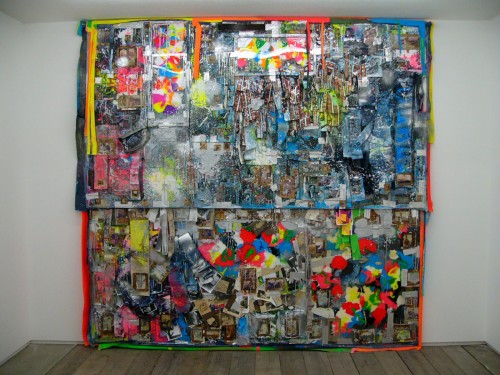 Shell & Occupy 4 Installation view at Take Ninagawa, Tokyo
Shell & Occupy 4 Installation view at Take Ninagawa, Tokyo– What in your own mind is the relationship between ‘pasting’ and ‘painting’?
They seem close but are actually far apart. I’ve no concept of combining painting and collage to form a particular style. For me, they have meaning precisely because they belong to different parts, and I need both to preserve a sense of balance. The pleasure I obtain from things I want to paste on places and things I want to paint is also completely different. Records for example have an A and B side, that is, two pages. Once I’d notice that records are ‘pages’ that make sound, I found myself wanting to stick them somewhere.
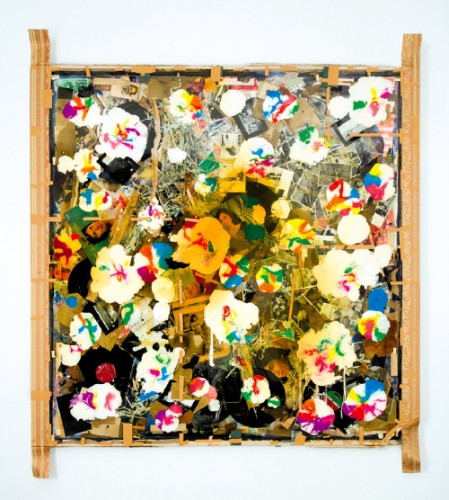 Poppy / Sound Shadow I 2008 205 x 195 x 5 cm Courtesy the artist and Take Ninagawa
Poppy / Sound Shadow I 2008 205 x 195 x 5 cm Courtesy the artist and Take NinagawaContinually contemplating the very act of creating
– Impulsive is a word that comes up frequently in discussions of your work, but I also get the impression that the source of your artistic expression lies in thinking about the act of making things in itself. Although in a different manner to any expository concept, or context.
First of all, artists have the luxury of assuming that they best understand the things they make. In fact they may understand them the least. Consider even just one way of looking at a painting: if it came into focus a millimeter from the canvas, the light would look completely different, and I doubt most artists would know the work as their own. Alternatively it would be fine to view it from 100 meters back. In reality though, there is a tacitly accepted appropriate distance for viewing a painting, and one gets the feeling the creator’s “luxury” is already latent in that tacit common sense.
At the moment there’s talk of reissuing production notes from my thirties in printed form, and revisiting them, I see I’ve written for example ‘possibilities for new paintings?’ and noted down ideas for this and that. Even if hardly any ideas bear fruit, I believe the thinking per se is interesting, and important. You can take something that people just vaguely assume to be a certain way, put a different slant on it, and really sock it to them, can’t you?
One could be Warhol making pictures by splashing urine on copper plate and letting it corrode, for example, or just buttering toast in the normal way: if you say something’s a picture, it becomes so. I’m constantly thinking about what sort of pictures I can do that no one’s ever done before. And even if you eliminate the unforeseeable, something puzzling and unexpected will invariably emerge. That’s what’s kept me interested all these years.
Ohtake Shinro
Born 1955 in Tokyo. Ohtake’s art practice encompasses myriad modes of expression including painting, photography, sculpture, collage and musical performance. Solo show Shell & Occupy 4 runs at Take Ninagawa to November 28. All works in 1 – 3 of the Shell & Occupy series unveiled last year, mixed with older works, can be seen at the I BELIEVE: Japanese Contemporary Art group show at the Museum of Modern Art, Toyama, to November 29. Ohtake also contributes a series of essays titled ‘Invisible Sounds / Unheard Pictures’ for the literary magazine Shincho, and provides illustrations (to spring 2010) for the novel Maou no ai (The Devil’s Love) by Miyauchi Katsusuke, serialized in papers including the Tokyo Shimbun.
ART iT Picks: Ohtake Shinro: Shell & Occupy 4
ART iT Snapshots: Ohtake Shinro @ Take Ninagawa
ART iT ArtPartner: Take Ninagawa
